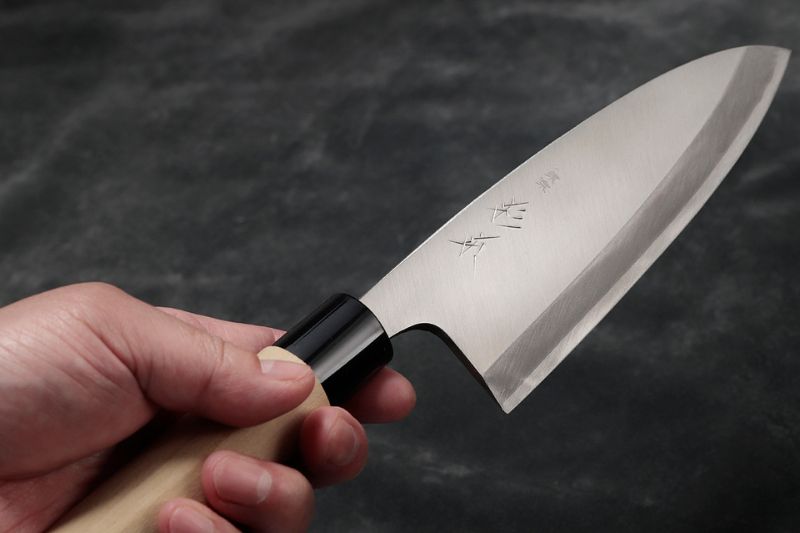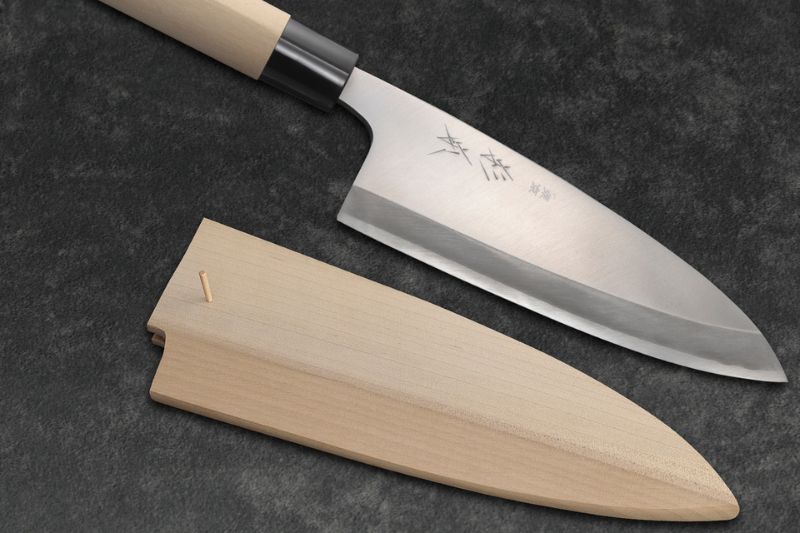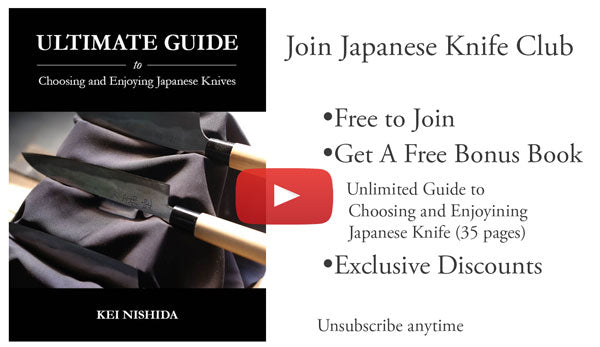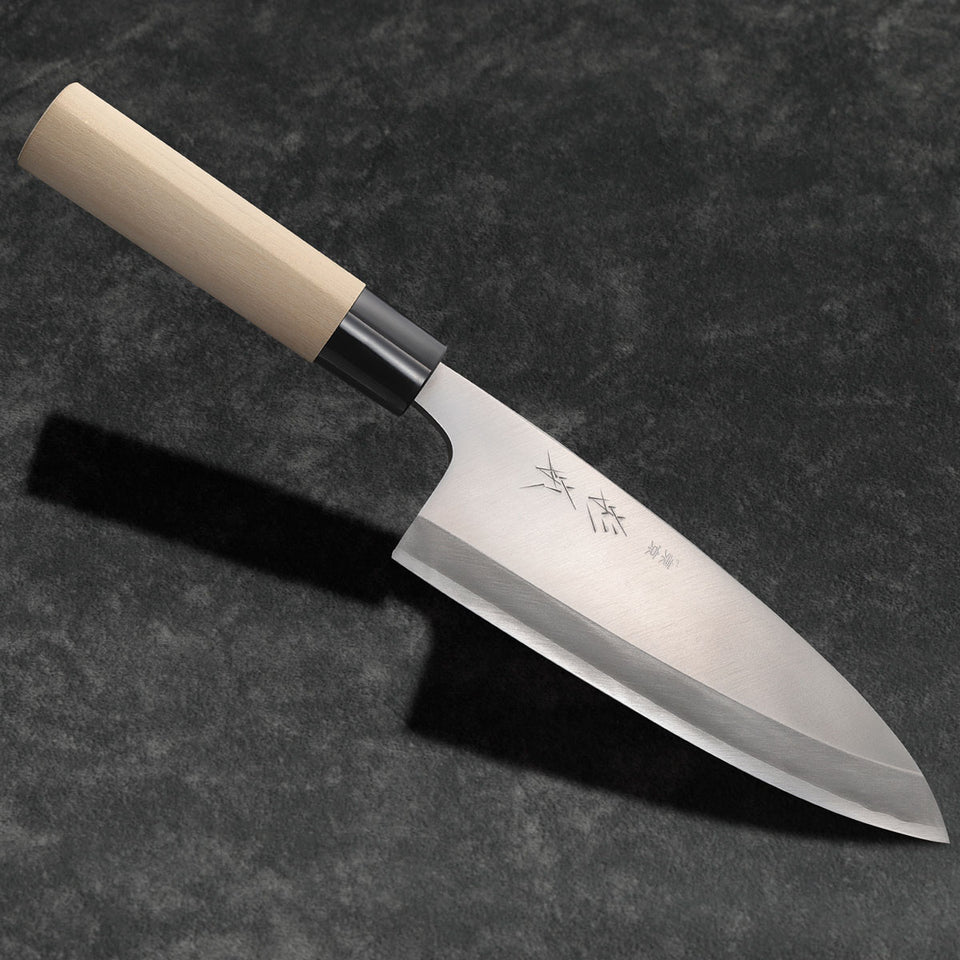The Deba Knife

The Deba (出刃), or Deba bocho(出刃包丁), is an essential knife in a Japanese kitchen. When translated literally, Deba bocho means 'pointed carver.' Traditionally used for beheading and filleting fish, there's no true equivalent to this knife in the Western kitchen. It functions both as a cleaver and a filleting knife. It's exceptionally versatile, and there's a reason that the Deba has been around for hundreds of years.
Not Just a Knife, a Cultural Shift: The Structure of this Article
I'm going take you through the creation, fall, and return of the Deba through history, which will give you an idea of its cultural importance. Then, we'll look at its innovative design that has endured for centuries. Lastly, I'll discuss the place of the Deba in cookery today. So, if you're wondering whether or not this knife is for you, read on. You'll soon discover that this unique knife is indispensable in the kitchen.

History of The Deba Knife
To fully understand the Deba and its design, you must understand a little bit of Japan's rich history and culture. Don't worry; this isn't a full-on history class. It's just an overview to explain the existence of the Deba today. So let's take a step back in time.
The Origins of the Deba Knife: During the Edo (江戸) era, the Japanese diet closely shaped how the Deba was born
The Deba has existed since the mid-Edo era, which spanned 1600 - 1868 CE when Japan was experiencing an extended period of peace and gradual urbanization. It was a vital tool at the time, given that the Japanese diet during this period consisted almost entirely of seafood and vegetables.
The Japanese Meat "Ban" caused the Prevalence of a Seafood-Based Diet
That’s because, since 675 CE, it had become taboo to eat other kinds of meat for religious reasons. Of course, that didn't stop the Japanese from sneakily eating whatever they liked, but it pushed the culture heavily toward fish consumption.
Hence, the People of Japan Required a Dedicated Fish Filleting Knife
Red meats only became prevalent in the late nineteenth century when Japan began trading with the West. So, having a knife for efficiently filleting fish was a must-have for every household and restaurant during this period. The invention of the Deba around 1700 was a crucial culinary step forward for an island nation sustaining itself primarily on seafood. No doubt, there were previous fish knives, but this was the only design that endured the test of time.
The Meiji Era Was a Huge Cultural Shift Toward Western Thinking
In the Meiji Era (明治 1868 - 1912 CE), along with interactions with the West, came new ways of living. The Japanese began to share their art and culture with the West. Likewise, the nation also began to take on Western culture, technology, and eating habits.
A New Western-Style Diet Took Over, and the Japanese Embraced Other Meats
The consumption of beef and other meats became more common and openly accepted. Towards the end of the era, new technologies such as stable refrigeration and increased urbanization made easily accessible fresh produce much more abundant.
There Was a Rise of Japanese Urbanites and Pre-Prepared Foods
Living a more fast-paced city lifestyle, it became more and more common for a growing urban class of Japanese to buy pre-cut pieces of fish at the markets. And as an alternative to traditional fish-only and vegetable-only knives, new multi-use designs such as the Gyuto became popular.
Post-World War 2, the Deba Began to Disappear as Japan Modernized
As a result, many households no longer required a Deba knife for home use. This trend became even more prominent after the 1940s as Japan took on ever-more Western influence, and the rural population kept shrinking.
The Deba Returns in the Modern Day
However, the Deba never wholly disappeared. Some Japanese home cooks continued to use the handy knife, and professionals still swore by its usefulness. Today, the Deba is making a solid comeback and impressing Western chefs.
Today, the West Adopts Japan’s Thinking With a Fresh New Way of Cooking
Indeed, in Western restaurants, many chefs now enjoy using super-sharp Japanese knives, including the Deba. On top of this, home cooks are becoming less concerned with convenience and more focused on the freshness and quality of meats. For many, there's a great appeal to filleting and butchering whole animals at home to keep food as fresh and flavorful as possible.

Features
A Heavy Knife with a Long Blade Made for Cutting Through Soft Bone

The Deba is uniquely designed. Its most prominent feature is the hefty blade. They can be purchased in substantial sizes, typically up to 180mm in length, and some beyond that. But no matter how long the blade, it will always be thick and heavy, tapering down to a sharp point. The weight gives it a fantastic ability to cut right through soft bones.
Japanese Ingenuity: a Single-Bevel Design for Incredible Precision

Additionally, the Deba has something that no traditional Western kitchen knife has: a single bevel. That means it is flat on one side rather than the edge coming to an even 50/50 point. This feature, an innovation also found in some other Japanese knives, makes it an extremely precise knife.
A Gentle Giant, the Deba is Still Elegant and Maneuverable

Because of its weight and size, you might expect the Deba to be inelegant. However, this single-bevel design and its pointed shape make it surprisingly maneuverable. You will find that it glides over fish bones and produces clean, neat fillets.
How to Use a Deba Knife
This Knife is, First and Foremost, for Meat
Sure, you can use a Deba to cut vegetables, but it will be less efficient and fine-cutting than a dedicated vegetable knife such as a Nakiri. It also won’t be as dynamic as a multi-use knife like a Gyuto, Bunka, or Santoku.
Avoid Too Much Chopping to Avoid Over Exertion
Because of its thick steel, your arm and hand may quickly tire if you try to use it for such tasks.
With that said, don't be afraid to use your Deba to roughly chop chunks of vegetables for a stew if you want to - the knife police aren't going to come to arrest you! Just be wary of using it for everything.
Instead, Use This Best-in-Class Specialist to Effortlessly Portion Whole Animals
When cutting up whole fish, chicken, and beef - you won't find anything better for the job. The Deba can easily cut through soft fish bones. It can also make easy work of the joints in a chicken. However, It is best not to try cutting through anything harder than that. Thick and hard bones should be avoided, and as with any knife, avoid cutting frozen foods. While you're unlikely to break a Deba, misuse can still damage the edge.
Use a Second Thinner Knife to Cut Like a Professional
After you make your fillets or portion your meat with the Deba, use a thinner knife to slice it. That's how sushi chefs keep their fish super-fresh and make mind-bogglingly thin slices. Yes, Gyuto and Bunka are great all-around knives, especially for those just starting in the kitchen. But specialist knives will take your cooking skills to the next level.
Let the Deba Do the Heavy Work and Make It Part of a Team of Knives
So if you're looking for something to make cutting meat effortless and like to keep your food as fresh as possible, consider pairing your everyday knife with a Deba. That way, you'll reduce the risk of chipping your more delicate knives and make cooking preparation easier. As you continue your knife journey, you’ll see the efficiency of having specialized knives. Choose the right tool for the right job.

Should I Buy a Deba?
The Deba isn't for everyone: don't buy one for your vegetarian friend! But, on the other hand, this is the perfect gift if you know someone who likes to fish. Or, if you're the sort of person who wants to step up their cooking skills and learn more about filleting and butchering their own meat, it's a fantastic tool.
Buying a Deba Will Save You Money and Reduce Waste
Additionally, portioning your own meat will save you money in the long run, and you can use the leftover pieces for homemade stocks. With a Deba knife, you'll have fresher ingredients and the satisfaction of using the whole animal. I wouldn't recommend it as a knife for beginners. However, a Deba will endlessly benefit those already confident in the kitchen.
Click here to learn more about this Deba KnifeGet Free Bonus Books

Sign up for free to the Japanese Knife Club to get advice and exclusive articles about how to choose Japanese Knives, and tips and tricks for using Japanese knives.
About the author
Kei Nishida
Author, CEO Dream of Japan
Certification: PMP, BS in Computer Science
Education: Western Washington University
Kei Nishida is a passionate advocate of Japanese craftsmanship, a writer, and the founder and CEO of Japanese Knife Co., Japanese Green Tea Co., and Japanese Coffee Co., all part of Dream of Japan.
His journey began with a mission to introduce the world to the exquisite flavors of Japanese green tea. Through Japanese Green Tea Co., he pioneered the import of premium tea grown in nutrient-rich sugarcane soil, earning multiple Global Tea Champion awards. He then expanded into the world of coffee, launching Japanese Coffee Co., the first company to bring Sumiyaki charcoal-roasted coffee to a global audience.
With a deep appreciation for Japanese artistry and tradition, Kei turned his attention to one of Japan’s most revered crafts: bladesmithing. Through Japanese Knife Co., he made handcrafted katana-style knives, created by a renowned katana maker, available outside Japan for the first time. These exceptional knives embody centuries of samurai sword-making expertise, blending tradition with modern functionality for chefs and collectors alike.
Kei’s journey continues as he uncovers and shares Japan’s hidden treasures—one sip, one blade, and one legacy at a time.


























